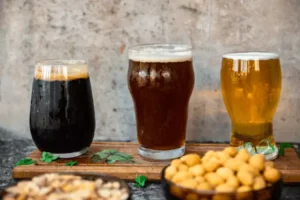
Your age, gender, sex, genetics, and how long you’ve been dependent all come into play. Over time, users may graduate from smoking marijuana to using it in high-dosage edible forms or propane-extracted concentrates called dabs. In healthy people, marijuana addiction marijuana is sometimes used as a substitute for other, stronger substances. Amanda Reiman, PhD, policy manager for the California office of the Drug Policy Alliance, and lecturer at the University of California Berkeley, shed light on this trend.
Who becomes addicted to marijuana and why?
These are people who have tried to quit on their own many times but couldn’t do it alone. People in mid-to-late adolescence are most likely to begin using cannabis. Some genetic studies suggest that developing cannabis addiction is hereditary. A Yale Medicine-led study identified several gene variants that increase risk of cannabis dependence. However, more research is needed in order to confirm the findings and understand how these genetic factors might contribute to marijuana dependence.
What are some negative consequences of cannabis use disorder?
Although it’s widely believed that marijuana is harmless, it’s possible to develop an addiction. According to the National Institute on Drug Abuse (NIDA), around 30% of people who use marijuana will develop marijuana use disorder. This risk is much higher for those who begin using the substance during adolescence. Many people who develop https://ecosoberhouse.com/ a marijuana habit are able to quit without entering a full-scale treatment center since the substance is not as harsh on the brain and body as other, “harder” drugs. Due to the constantly evolving social landscape surrounding marijuana, it can be difficult to determine if you have a problem and even more challenging to stop using.

I’m In Recovery
Undergoing behavioral therapy can help you understand your addictions and motivations better. This is a great way to arm yourself against cravings and relapses. With a primarily psychological drug like marijuana, it is also crucial to implement cognitive behavioral therapy as well as other therapeutic methods. Substance dependence, also called chemical dependence, is when a person experiences physical dependence on a substance but is not addicted to it. One example is when a person who has taken a prescription medication for a long time stops taking that medication and experiences physical or mental withdrawal symptoms.
- “If I try to cut down or stop my intake and have negative consequences — cravings, irritability, upset stomach, chills, etc. — that could be a sign that my use has become dependence.
- Everyone goes through the process in different ways, don’t be deterred if you feel your journey seems to be taking longer than it should.
- The American Psychiatric Association’s most recent criteria for substance use disorders include tools to identify cannabis addiction.
- The plant has historically been used recreationally for its mind-altering effects, which can include enhanced senses and changes in mood.
- Along with having trouble breathing, you might feel like you’re having an asthma attack or have less oxygen in your lungs.
If you already have heart disease, your risk of a heart attack goes up even more if you use marijuana within 60 minutes of getting anesthesia. Tell your doctor if you use pot so they can keep an eye on your risk. People who have recently used or chronically use marijuana might take longer to empty their stomachs. Because of this, if you use pot, you’re at risk of your stomach contents coming back up into your throat and being sucked into your lungs before your anesthesiologist is able to put in your breathing tube. If you or a loved one are struggling with marijuana misuse, WebMD Connect to Care Advisors are standing by to help.

Treatment for Cannabis Use Disorder
These symptoms are temporary and will cease when you are done with your detox. Unlike other substances like opioids, detoxing from marijuana doesn’t carry any significant risks in the detox process. Your experience with the detox process is dependent on a combination of several factors.
- The diagnosis captures the possibility that people can be negatively impacted by marijuana use without necessarily being addicted.
- These statistics paint a sobering picture, but they only tell part of the story.
- It’s also important to note that marijuana potency has increased significantly over the years.
- The financial strain of supporting a marijuana habit can be substantial, especially as tolerance builds and users require more to achieve the desired effect.
- The United States Drug Enforcement Administration (DEA) put together five Schedules (categories or classifications) of controlled substances.
You can either gradually wean yourself off the drug or stop smoking cold turkey. The downside, however, is that you are more likely to relapse when detoxing yourself. This is because there’s a lack of supervision and accountability from a person of authority. “There are people who have a glass or two of wine a day,” said Hart. “In fact, a glass or two of wine a day is considered healthy… Now, you certainly might see some sort of withdrawal symptom if someone’s been drinking for a few years and they abruptly stop doing that.
- Approximately 1 in 10 people who use marijuana will develop cannabis use disorder.
- You might be confused about what’s happening with your body during a withdrawal.
- “The problem isn’t that they are releasing less dopamine, but that the dopamine stimulation in the brain is having a very attenuated effect,” Volkow said.
- “Marijuana-addicted people rarely present for treatment,” said Stalcup.
- Again the detox journey from marijuana varies from individual to individual.
- Lifestyle changes such as staying busy, maintaining connections with supportive loved ones, joining support groups, and avoiding drug triggers can also be helpful.
A 2017 study reported that adult cancer patients are using marijuana to ease nausea and other symptoms. Additionally, many treatment facilities accept credit cards and have financing options as well. One approach, call motivational interviewing, helps to turn ambivalence about quitting into energy to quit. Like the naturally occurring cannabinoids present in the cannabis plant, there are a number of synthetic cannabinoids that are made in a laboratory. Food and Drug Administration to treat nausea and vomiting induced by chemotherapy, both available in capsule form. Marijuana addiction can be challenging both for the person experiencing the addiction and for those around them.
The financial strain of supporting a marijuana habit can be substantial, especially as tolerance builds and users require more to achieve the desired effect. Legal issues, particularly in areas where marijuana remains illegal, add another layer of stress and potential consequences. The fear of getting caught, the cost of legal fees, and the impact on future employment opportunities can create a vicious cycle of anxiety and increased use. Professional and academic setbacks are another hidden cost of marijuana addiction. The motivation and drive that once fueled ambitions can be dulled by constant use. Many users report difficulty concentrating, decreased productivity, and a general sense of apathy towards their goals.

At this time, there is no medication approved by the Food and Drug Administration (FDA) to treat cannabis use disorder, though some medicines are currently under investigation. Until such options exist, cannabis use disorder is best treated through counseling and therapy. Marijuana misuse turns into addiction when you can’t stop using the drug even though it’s affecting things like your job or your relationships.
